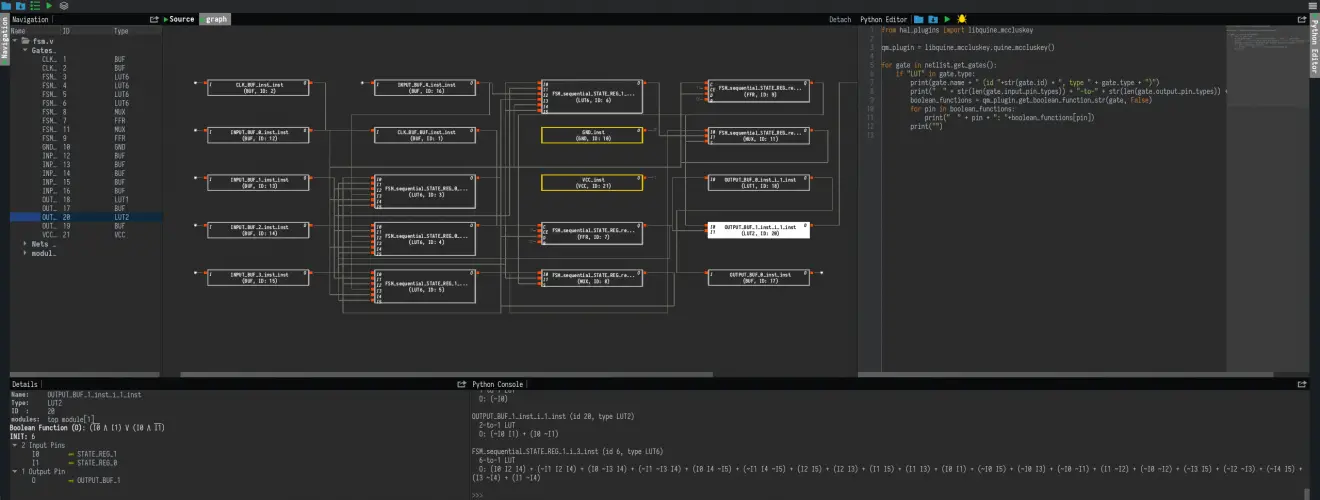HAL v4.2 releases: The Hardware Analyzer

HAL- Hardware Analyzer
Hardware Analyzer (HAL) [/hel/] is a comprehensive reverse engineering and manipulation framework for gate-level netlists focusing on efficiency, extendability, and portability. HAL comes with a fully-fledged plugin system, allowing it to introduce of arbitrary functionalities to the core.
Features
- Natural directed graph representation of netlist elements and their connections
- Support for custom gate libraries
- High-performance thanks to optimized C++ core
- Modularity: write your own C++ Plugins for efficient netlist analysis and manipulation (e.g. via graph algorithms)
- A feature-rich GUI allowing for visual netlist inspection and interactive analysis
- An integrated Python shell to exploratively interact with netlist elements and to interface plugins from the GUI
Changelog v4.2
- GUI plugin manager
- WARNING: modified plugin core API – reduced number of base classes and instead added extension components
- added overview of loaded plugins and their features
- added interactive buttons to load and unload plugins
- added feature to load plugin automatically if needed for file parsing
- prevent unloading of plugin if it is needed as a dependency of another plugin
- changed plugin load policy to have only mandatory or user required plugins loaded at startup
- Boolean functions
- added
BooleanFunction::substitute(const std::map<std::string, std::string>&)to substitute multiple variable names at once - changed
BooleanFunction::get_constant_valueto returnstd::vector<BooleanFunction::Value>, thereby removing the 64-bit limit - added
BooleanFunction::Node::get_constant_value,BooleanFunction::Node::get_index_value, andBooleanFunction::Node::get_variable_name - added
BooleanFunction::get_constant_value_u64andBooleanFunction::Node::get_constant_value_u64to retrieve the constant value asu64if it comprises less than 64-bit - added
BooleanFunction::has_constant_value(const std::vector<BooleanFunction::Value>&)andBooleanFunction::Node::has_constant_value(const std::vector<BooleanFunction::Value>&) - added
BooleanFunction::algebraic_printeras an alternative printer forBooleanFunction::to_stringto print a Boolean function in algebraic form - added shift and rotate operators
Shl,Lshr,Ashr,Rol, andRor
- added
- plugins
boolean_influence- added deterministic variants of all Boolean influence functions that shall be used for Boolean functions with only few input variables
- added additional parameters for more control to the subcircuit and gate variants of
get_boolean_influence
netlist_preprocessing- added
decompose_gates_of_typeanddecompose_gatethat decompose combinational logic gates into basic gate types - added
parse_def_fileto parse a Design Exchange Format file that contains placement information simplify_lut_initsnow annotates the original init string into the data container
- added
verilog_parser- added annotation of all net names that where merged during parsing in the data container
- added implicit wire declarations for assign statements
- changed the behavior of the parser when flattening a netlist and generating new unique names (instead of appending an index we now add a prefix containing the names of parent modules)
z3_utils- added
compare_netlistsfunction that functionally compares two netlists that only differ in their combinational logic - removed class
z3Wrapper - renamed
to_z3tofrom_bfand added support for missing node types - renamed
to_haltoto_bfand added support for missing node types - changed
to_cppto output only the C++ code implementing the Boolean function and nothing more
- added
dataflow_analysis- added API to interact with dataflow analysis results from C++ and Python
- added automatic creation of pin groups for data and control pins of register modules
- added parameter to only write or retrieve information on certain register groups
- deprecated
plugin_dataflow::executeas its functionality is now split betweendataflow::analyzeand the members ofdataflow::Result - removed file writes if not explicitly called by user
netlist_simulation_controller- added versions of
add_waveform_grouptaking a module pin group as input - added versions of
set_inputtaking aWaveDataobject, vectors of nets and values, aWaveDataGroupand a vector of values, and a module pin group and a vector of values as input
- added versions of
solve_fsm- changed both versions of fsm_solving to now not only consider data inputs of the state register, but also synchronous control signals.
xilinx_toolbox- added the first version of the xilinx_toolbox plugin that provides functionality especially fitted to xilinx fpga netlists
- decorators
- added
NetlistModificationDecorator- added
delete_modulesto delete all (or a filtered subset of) the modules in a netlist - moved
replace_gatefromnetlist_utils, now returns pointer to replacement gate - added
connect_gatesto connect two gates at the specified pins via a new or already existing net - added
connect_netsto merge two nets into one, thereby connecting them
- added
BooleanFunctionDecorator- added a version of
get_boolean_function_fromthat takes a module pin group as input
- added a version of
- added
- selection details widget
- added
Focus item in graph viewto several context menus - added
Isolate in new viewto gate/module related context menus - changed
Isolate in new viewpolicy for modules: open exclusive module view if such a view already exists - improved drag&drop functionality to move module pins and merge module pin groups
- added
- miscellaneous
- added
Gate::get_modulesto recursively get all modules that contain the gate by traversing the module hierarchy - added
Net::is_a_source(const Gate*)andNet::is_a_destination(const Gate*)that check whether a gate is a source/destination independent of the gate pin - added
PinGroup<T>::contains_pinto check whether a pin is part of the respective gate or module pin group - added overloaded version of
deserialize_netlistthat takes a gate library, thereby overruling the gate library path in the .hal file - added
utils::wrapped_stoullandutils::wrapped_stoulthat wrap the standard string to integer conversion and usehal::Result<>for error handlung instead of exceptions - added utility function
is_valid_enumto check whether the string representation of an enum value is valid. - added serialization of physical gate positions (non-negative integer)
- added keyboard shortcuts for fold, unfold, and remove from view
- added
filterparameter toget_fan_[in/out]_[nets/endpoints] - added pyBinds for the
LogManagerclass - added pyBinds for the
ProjectDirectoryclass - added
Module::move_pin_groupto change the order of pin groups of a module - changed abort being more responsive when aborting layouting of large views
- changed and improved color scheme for light style
- changed labels on HAL startup screen to better resemble the new project structure
- removed toolbox from groupings widget
- added
- bugfixes
- fixed build from tarball
- fixed minor navigation bugs on settings page
- fixed missing Python bindings for
GatePinGroup - fixed
SolveFsmPluginnot properly replacing power and ground nets in Boolean functions - fixed searchbar attempting time consuming search when there is no content to search
- fixed some documentations of core functions
- fixed igraph not building anymore by relaxing irgaph compiler options
- fixed Python GUI API being unavailable at runtime
- fixed nets without source or destination not being shown when unfolding the module they belong to in the selection details widget
- fixed cmake failing to parse HAL version number from file
- fixed pins and pin groups not being hashable in Python
- fixed Python script execution abort button disappearing when switching tabs
- fixed segfault when deleting a module for which an exclusive view exists
- fixed not loading all plugins if the GUI is not in control
- fixed Verilog writer not being a dependency of Verilator plugin
Install && Tutorial
Copyright (c) 2019 Ruhr-Universität Bochum, Lehrstuhl für Eingebettete Sicherheit. All Rights Reserved.
Copyright (c) 2019 Marc Fyrbiak, Sebastian Wallat, Max Hoffmann (“ORIGINAL AUTHORS”). All rights reserved.







